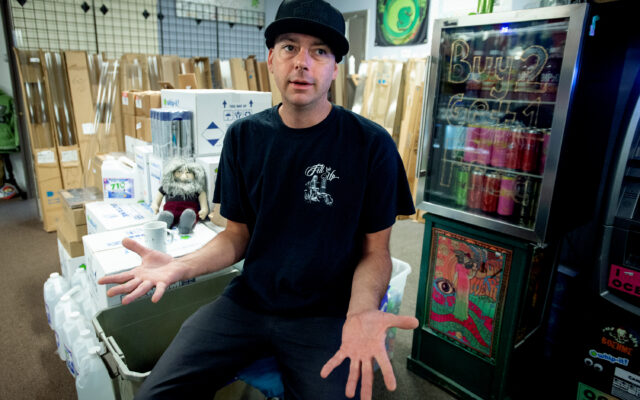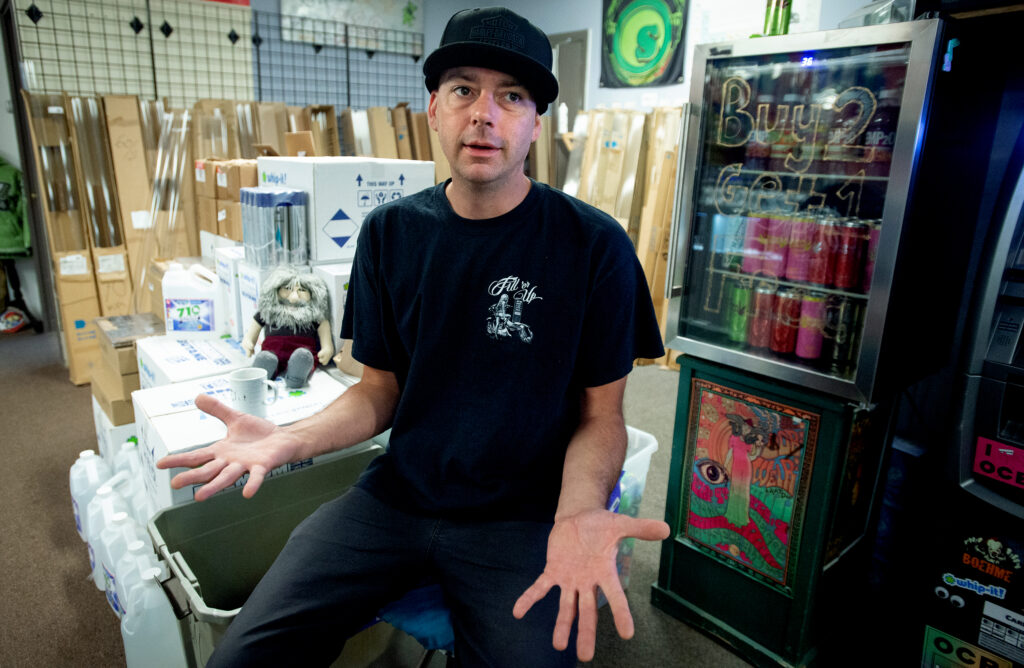
High Trump support is strongest predictor of Penobscot towns’ low COVID vaccine rates
By David Marino Jr., Bangor Daily News Staff
Pam Carmichael says it’s unlikely she’ll ever get vaccinated against COVID-19.
The Greenbush resident takes precautions such as avoiding large crowds, but she sees a significant distinction between being unvaccinated in a rural place like Greenbush and a metropolis like New York City.
“Out here, I don’t use a bus or a taxi or subway,” said Carmichael, 70. “It’s not close like the big cities.”
Eric Gustin hasn’t been vaccinated, either, but for a different reason. The 45-year-old owner of the Newport smoke shop Greenbear420, Gustin said he is uncomfortable with the Messenger RNA technology used in the Pfizer and Moderna vaccines. The mRNA technology teaches the body’s cells to make a protein that triggers an immune response against COVID-19.
While more than three-quarters of those who live in Bangor and bordering towns have received at least one dose of a COVID-19 vaccine, vaccination rates in the rural communities to Bangor’s north and west are generally substantially lower, according to Maine Center for Disease Control and Prevention ZIP code-level data.

VACCINE CONCERNS — Eric Gustin, 45, of Dexter, is the owner of Greenbear420, a smoke shop in Newport. Gustin hasn’t been vaccinated because he is uncomfortable with Messenger RNA technology.
Given the wide availability, not getting vaccinated is now a matter of choice — with potentially enough people making that choice that it could allow the virus to continue to spread and keep Maine from achieving herd immunity.
In Greenbush, 45 percent of residents had received a vaccine dose as of June 14, giving it one of the lowest rates in Penobscot County. In Newport, it was 57 percent. In Dexter, where Gustin lives, 62 percent.
By contrast, 85 percent of those living in the Orrington, Hampden and Newburgh ZIP codes had received at least one vaccine dose. Brewer, Holden, Bangor, Glenburn, Veazie and Hermon weren’t far behind.
Over the past week, the Bangor Daily News visited some of the Penobscot County towns with the lowest vaccination rates, and a statistical analysis showed those communities’ support for former President Donald Trump was the strongest predictor of their low vaccination rates.
In interviews, some residents of towns with low vaccination rates voiced distrust in the science behind the vaccines or said they disliked vaccines in general. Some said they were not afraid of COVID-19 and were willing to accept the social consequences associated with not getting the shot. Many echoed discredited conspiracy theories. Some said they wanted to wait for more information or to see if those who were vaccinated experienced long-term side effects before getting the shot.
‘Just a little more research’
Amanda Gillis, 41, has no plans to get the shot.
The Detroit resident’s perspective reflects that of many who refuse to. She feels that the rollout was too fast, and she doesn’t feel comfortable doing something the federal government is asking her to do.
The COVID-19 vaccines from Pfizer and Moderna were created with a method that has been in development for years, and the companies conducted some of the steps on an overlapping schedule to gather data faster, according to Johns Hopkins Medicine.
Gillis didn’t rule out ever getting vaccinated. There is a possibility, she said, if a few years go by and people who get the shot show no side effects.
It hasn’t always been easy being unvaccinated, she admitted. Her loved ones have warned her to be careful going out in public. Yet she feels steadfast about her decision.
“All the power to them — that’s what they choose,” Gillis said. “I didn’t harass my family members or friends about getting it.”
Some people are more adamant about their opposition to the vaccine than others.
Josh Pinkham, 42, of Corinth, said he would be open to getting vaccinated but felt the rollout was too rapid. He said he was waiting for more information. He also disagreed with misinformation he had seen on Facebook about the health consequences for those who have been vaccinated.
“I’m not an anti-vaxxer,” Pinkham said. “Just a little more research, and I’ll be getting it just to help with the herd immunity.”
Institutional distrust, support for Trump
As it stands today, nearly 60 percent of all Mainers are fully vaccinated, giving the state one of the highest vaccination rates in the country.
The large number of holdouts, however, boils down to a lack of trust in institutions, said Dr. Peter Millard, a former epidemiology staffer at the U.S. Centers for Disease Control and Prevention and an adjunct professor at the University of New England.
The distrust didn’t begin with the COVID-19 vaccine, Millard said. Rural Maine has seen several well-paying jobs leave with the decline in manufacturing — a story that holds true for many of the rural communities across the country where vaccine hesitancy is highest.
“They’re hesitant to get the vaccine because they are really not quite sure that it’s safe or effective,” Millard said.
The solution has little to do with the larger institutions many Americans distrust, he said. They are far more likely to trust local leaders, including priests and doctors.
Jim Sullivan, 50, of Kenduskeag, who is vaccinated, was not surprised that so many people in rural Penobscot County were choosing not to get the shot. Many had not worn masks throughout the pandemic. And there’s a strong correlation between support for Trump and a resistance to getting inoculated.
In fact, the percentage of residents who voted for Trump in the 2020 presidential election was the strongest predictor of a community’s vaccination rate, according to a correlation analysis using Maine CDC and U.S. Census data. A high Trump vote share was a stronger predictor of a low vaccination rate than a community’s median age, median household income or ruralness. Household income, followed by population density, were the next strongest predictors.
Penobscot County ZIP codes where a majority of residents voted for the former Republican president had a median vaccination rate of 58 percent, while those where a minority backed Trump had a median vaccination rate of 71 percent.
It is a phenomenon that has been observed nationwide, despite the fact that the federal government spearheaded the vaccine’s creation under the Trump administration.
Trump received the COVID-19 vaccine while president in January, though he was the only living president not to be photographed doing so and has received criticism for not doing enough to encourage his supporters to trust the science behind the vaccine.
‘They can go out safely’
While many question the COVID-19 vaccine’s benefits, others point to the advantages that have already come with a higher vaccination rate.
It has brought many positive changes for local restaurants and bars, said Mark Horton, 43, of Old Town, the co-owner of Woodman’s Bar and Grill in downtown Orono.
Horton, who is vaccinated, said he had seen more pre-pandemic regulars return with rising vaccination rates. The increasingly safe environment also gives him more options as he looks to introduce later bar hours by the middle of summer.
“Not everybody felt 100 percent safe going to a restaurant last year,” Horton said. “Now, vaccinated people don’t have that worry. They know they can go out safely.”
Despite being less rural and conservative than many of its neighbors, Orono also has one of the lowest vaccination rates in Penobscot, with 54 percent vaccinated. It is likely because the town is so young. The median age is 22, and those 20-29 are still one of the age groups least likely to be vaccinated.
There is worry from state officials that rural vaccine hesitancy could lead to continued cases and outbreaks, Maine CDC Director Nirav Shah said. Yet, he said, perspective is important. Even many of Maine’s most vaccine-hesitant communities are outpacing much of the country.